Agrivoltaics is a concept in which a piece of land is simultaneously used for both energy and food production by mounting photovoltaic modules at a certain height above (or in between strips of) agricultural land. A local and system-level incorporation of water management is imperative to the sustainable implementation of agrivoltaics. Water raining on the module can be gathered and used for distinct purposes: groundwater recharge, crop irrigation, and cleaning and cooling of the PV modules. This research provides an initial overview of positive and negative impacts for each water use concept and outlines issues that should be taken into consideration and the potential for research and development. Various Managed Aquifer Recharge (MAR) technologies are a way to clean and store the water periodically in an underlying aquifer. Irrigation increases yield within the plant level and therefore increases the system’s output. Thanks to the power supply generated by the PV modules, high-tech irrigation systems can be implemented in agrivoltaic systems; the special adaption of irrigation systems to agrivoltaics poses significant potential for research and development. Meanwhile, the necessity, i.e., profitability of cleaning and/ or cooling PV modules depends on local environment and economic factors. Several cleaning techniques have been developed to mitigate soiling, ranging from manual cleaning to fully automatic cleaning systems. In agrivoltaics systems, the soiling risk can increase. Semi-automatic systems seem to have the greatest potential for agrivoltaics, because they can be used with farming equipment. Multiple cooling techniques have been developed to decrease cell temperature to increase power output, with some of them involving water. Water flowing over the module surface is a promising a promising cooling technique for agrivoltaic applications. Attaching a perforated tube to the upper edge, the entire module can be covered in a thin film of water which cools very effectively (while also cleaning the surface). A closed-circuit system could be created involving the technical components used for rainwater harvesting. The economic feasibility of cooling panels in agrivoltaic systems needs to be investigated. In certain locations, rainwater-harvesting could also be relevant for ground-mounted PV systems.
Tag Archive for: solar farming
Australian Researchers Develop Solar Panels Optimized for Agrisolar
“University of New South Wales researchers have teamed up with Tindo Solar to develop a line of semi-transparent modules, specialized for agrivoltaic cropping, which will use nanoparticles tuned to capture different parts of the light spectrum. ‘There is evidence you don’t need the full spectrum and some plants will work even better if you provide them with only part of the spectrum,’ project lead and UNSW Associate Professor Ziv Hameiri tells PV Magazine Australia. Crucially, he says, the project will also open a line between farmers, solar researchers and industry, creating the potential for mutual benefits.” – PV Magazine
Agrisolar Operations Show That Solar Does Not Compete with Farmland
“In short, Agrivoltaics is a rapidly growing branch of the energy transition. It is being applied to all manner of crops across the world. All kinds of benefits are emerging, with China even using it to reverse desertification. Not only is it expanding clean energy production, it is providing a vital second income stream for farmers. Banning it would cut off a really important opportunity for Britain’s farmers, at a time when rural poverty is a real issue.” – Green Peace
Oregon State Develops 5-Acre Agrisolar Project
“Oregon State University has started construction on a $1.5 million research project to optimize dual-use, co-developed land hosting solar photovoltaic arrays and agriculture. The five-acre Solar Harvest project is located at Oregon State’s North Willamette Research and Extension Center in Aurora, Oregon, 20 miles south of Portland. The 326-kW project is the result of a partnership between Oregon State and the Oregon Clean Power Cooperative, which developed the solar array and financed the construction of the solar array.” – Solar Power World
Solar Projects Increase Tax Revenue in North Carolina
“Proposed large-scale solar facilities continue to draw opposition in North Carolina from critics who argue that swaths of panels are blights on the landscape and threaten farms in a state where agriculture is the leading industry. But those facilities have become a financial boon to local communities, particularly in rural areas with limited sources of tax revenue, a newly released study from the N.C. Sustainable Energy Association found.” – Greensboro
Dutch Research Studies Agrisolar
“During a four-year pilot project, Dutch independent research organization TNO, in collaboration with Vattenfall and Aeres University of Applied Sciences (UAS), is developing a sun-tracking algorithm that monitors various factors, such as crop yield, energy yield and the effects of herb strips, weather forecast, energy price and soil condition.” – Vattenfall
Small Farms in Maine are Good Candidate for Agrivoltaics
“Maine’s prevalence of small farms with low-lying, hand-harvested crops makes the state a good candidate for blending solar energy and food production on the same land, but farmers may not take the risk without funding for pilot projects.
Maine may be uniquely positioned for this emerging field, known as agrivoltaics or dual-use solar. Nationally, most successful projects so far have involved extras like solar grazing or pollinator habitat alongside panels at small farms with low-lying, hand-harvested crops — precisely the type of farms that dominate much of Maine’s agricultural sector.” – Energy News
African Company Provides Agrisolar Refrigeration
“A company called AkoFresh is providing solar-powered refrigerated storage that it says extends the shelf life of perishable crops from about 5 days to 21 days. This will boost seasonal income for farmers by more than $10 million, as well as reduce greenhouse gas emissions by 15%. Farmers can rent a space in the cold store for a daily fee of $0.30 per 20-kilogram crate of produce or take up a weekly subscription. They can also pay for the cold storage with crops instead of cash.” – World Economic Forum
Research Being Conducted at Pennsylvania Agrisolar Site
“In recent years, the environmental management of solar farms has become an exciting area of academic research, to assess how different practices affect the productivity of solar and agricultural enterprises and the land on which they operate. Two studies seeking to answer research questions around these topics are currently underway at Lightsource bp’s Nittany 1, 2 and 3 solar projects in Pennsylvania.
All three sites were designed and are being actively managed to boost biodiversity and support pollinator populations, in addition to generating clean energy for Penn State and their students. Lightsource bp seeded the sites with a mix specifically formulated by the American Solar Grazing Association (ASGA), in partnership with Ernst Conservation Seeds and Pollinator Service. The seed mix, aptly named ‘Fuzz and Buzz,’ was designed to support pollinator species at solar sites, in addition to flocks of sheep. At Nittany 1, more than 700 sheep are managing vegetation through rotational grazing, an example of agrivoltaics, or co-located solar and agriculture.” – Lightsourcebp
New Zealand Solar Farm Will Host Sheep
“Harmony Energy New Zealand has been granted approval to develop a solar farm in the Waikato which will generate electricity to power 30,000 homes as sheep graze underneath. The Environmental Protection Authority (EPA) has approved Harmony’s proposal for approximately 330,000 solar panels to be installed on 182 hectares of a 260-hectare site at Te Aroha West. The land will remain in the ownership of Tauhei Farms Limited, with livestock grazing continuing with sheep, rather than the current dairy herd.” –https://www.stuff.co.nz/business/300693453/hauraki-solar-farm-that-could-power-30000-homes-gets-green-light Power Technology
By David Murray
In the 1940s, my great-grandfather purchased a small farm in the Hudson Valley of New York. He raised chickens and grew tomatoes, strawberries, and other crops until he passed away. My extended family treasures this farm, but with every passing year, maintaining it becomes less economic. The temptation to sell the property gets stronger.
Thousands of small farmers across America share my family’s story. The agriculture industry is increasingly consolidated, moving to a large, corporate business model. Farming technology has advanced rapidly, leading to crop prices are driven low. Small, independent farmers are often pushed out of the market. Meanwhile, real estate development in rural areas and suburban sprawl creates a pull: from 2001 to 2016, the U.S. converted 11 million acres of farmland to non-agricultural uses, with low density residential land use as the primary driver.
On one hand, the trend is unsurprising: as we become more efficient at growing food, we require less land – and fewer people – – to farm. On the other hand, small farmers play an important role in our food system, and families like mine should be able to pass a successful operation down to the next generation. For many families, solar energy provides that opportunity.
Leasing land to a solar developer provides stable, consistent income, helping some farmers avoid having to sell the land, which often gets converted to housing, commercial real estate, or other uses. In this manner, solar energy protects against what conservation organizations fear the most: low-density, suburban sprawl.
Solar energy development can also preserve the land: after approximately 30 years, the next generation can convert the property back to agricultural use. Finally, many farmers are already accustomed to supporting America’s energy needs: over 30 million acres of farmland are used to grow corn for ethanol.
Of course, farmers need to think long term: what are the impacts to the land from solar development? One benefit is nutrient runoff: solar facilities require less fertilizer than most crops; thus, nutrient runoff from solar facilities is typically less than the pre-existing agricultural use. Native grasses and legumes also mitigate erosion and improve water quality by intercepting sediment and nutrients. Solar development also cuts down on pesticide and insecticide use. Herbicide may be used during the site preparation process, but more sparingly once the facility is in operation. For arid regions, solar reduces water use – leaving an increasingly valuable resource to neighboring farming operations.
However, for families like mine that want continue using our farm to grow food and feed, agrivoltaics provides an exciting opportunity. This is why the American Clean Power Association is happy to work with the National Center for Appropriate Technology’s AgriSolar Clearinghouse to make agrivoltaics an increasingly financially feasible option for farmers.
Solar grazing is a bright spot. While letting sheep into an active power plant comes with a unique set of challenges, in certain cases it can be cheaper than a traditional landscaping crew. Data from the American Solar Grazing Association shows smaller projects are more likely to use solar grazing, but the association recently noted that a 200-megawatt (MW) solar project is slated to incorporate sheep into its vegetative management plan. For sites where solar grazing works, it can be an excellent win-win-win.
In the meantime, the industry is working to bring down costs of other forms of agrivoltaics, such as crop production underneath panels. A key challenge is raising the height of solar panels to accommodate farming. Unfortunately, raising solar panels significantly increases costs, as the piles need to be taller and driven further into the ground. Expensive machinery – such as a scissor lift – is needed to install piles deep enough to ensure they are secured properly to resist heavy winds. These lifts are not designed for use on solar sites. Furthermore, this process requires more labor to successfully deploy the equipment. This is an example of a major challenge that ACP is excited to work with NCAT on to make agrivoltaics more widespread.
We are aiming for a future where many types of agrivoltaics can scale, while ensuring that solar energy remains one of the cheapest forms of new energy generation. Thus, ACP will continue engaging with NCAT to identify ways to bring down the costs of agrivoltaic projects and continue to foster partnerships between the solar industry and agriculture sector.
David Murray is the Director of Solar Policy at the American Clean Power Association.
Vermont Agrisolar Study Shows that Saffron Grows Well Under Solar Panels
“A study released earlier this year summarized the results of a three-year experiment conducted by the University of Vermont. The research concluded that, given the right soil conditions, saffron grows well in the aisles and at the edges of a solar array, which could boost bottom lines for farmers by allowing them to draw dual revenue streams from a single section of land.
‘We could see diversified vegetable growers growing lots of spinach and kale, but they weren’t making any money at it because everybody was growing the same thing. We felt saffron offered an opportunity for these growers to add a high-value crop,’ said Margaret Skinner, a researcher at the University of Vermont.
According to the study, “when soil conditions are suitable, saffron can be grown successfully within a conventional tilted solar array, generating between $7,500 – 130,000 per acre.” – Energy News Network
University of Maine Studies Agrisolar Blueberry Yield
“A farmer in Maine has teamed up with a solar developer and university researchers to find out how his (blue)berries fare when partially shaded by solar panels. The University of Maine is studying this example of dual-use agrivoltaics.
The solar installation was developed by the Boston-based solar developer BlueWave, and it is owned by the company Navisun, which makes lease payments to the landowner. Sweetland tends, harvests, and sells the blueberries, and shares profits with the landowner.
The university (Maine) received grant funding to continue the study for three more years from the Northeast Sustainable Agriculture Research Education program, which is supported by the U.S. Department of Agriculture’s National Institute of Food and Agriculture. The research team will compare the blueberry yield among the plants fully shaded by panels, plants partially shaded by panels and plants with full sun. The panels are 8 feet tall in rows spaced 8 feet apart.” – Canary Media
Wisconsin Dairy Farmer Finds Financial Safety in Agrisolar
“Brent Sinkula, president of the Manitowoc County Farm Bureau, understands the challenges Wisconsin dairies are facing. The changing dairy market has made it more difficult for small and mid-sized farms to continue. Without plans to expand the dairy, Sinkula was looking for another way to maintain the family farm. In 2018, an energy company approached him interested in renting 500 acres, about a third of his land, to install solar energy panels.
For Sinkula, hosting solar panels on his land provides a financial safety net for the farm. He’s not the only farmer to make similar arrangements. Farmers have what solar energy companies need: land. Across the state, partnerships between dairy farms and energy companies are increasing, changing the landscape and providing farmers extra revenue in a sometimes unpredictable market.” – WPR
The Solar Industry’s Mower of Choice: Sheep
“The panels blanket nearly 1,500 acres of a solar farm in Deport, a town near the Oklahoma border. Ely Valdez, the boss, makes sure prairie grasses don’t block sunshine from the panels. His sheep do most of the work. Sheep, the surprise workhorse of renewable energy, are generating several million dollars in annual revenue tidying up solar farms nationwide.
‘It’s changing all of our lives,’ said Mr. Valdez. He expects the flocks he oversees to soon generate several hundred thousand dollars in annual revenue. The number of acres of solar fields employing sheep in the U.S. has grown to tens of thousands from 5,000 in 2018, according to estimates by people in the business. Flock owners charge as much as $500 an acre a year.
The solar industry auditioned several methods for the job, but requirements weeded out expected contenders. Power mowers, which can’t maneuver easily enough under panels to avoid the risk of damaging equipment, are of limited use. “Sheep truly are the appropriate technology for this,” said Michael Baute, vice president of regenerative energy and carbon removal at solar developer Silicon Ranch Corp., based in Nashville, Tenn.” – The Wall Street Journal
The “Five C’s” of Agrivoltaics
“These are among the most important findings of an ongoing agrivoltaics research project called Innovative Solar Practices Integrated with Rural Economies and Ecosystems (InSPIRE). Led by the National Renewable Energy Laboratory (NREL) and funded by the U.S. Department of Energy’s Solar Energy Technologies Office, InSPIRE has just completed its second, three-year phase of research into the synergies between solar energy and agriculture.
In its first phase, InSPIRE tried to quantify the benefits of agrivoltaics and record some early best practices in the emerging field. The project adopts a big-tent approach to agrivoltaics, welcoming any dual use of solar-occupied land that provides ecological or agricultural benefits. That could mean grazing cattle or sheep, growing crops, cultivating pollinator-friendly native plants, or providing ecosystem services and restoring degraded soil.
The InSPIRE project found five central elements that lead to agrivoltaics success, summarized as ‘the five C’s’:
- Climate, Soil, and Environmental Conditions — The ambient conditions of a location must be appropriate for both solar generation and the desired crops or ground cover.
- Configurations, Solar Technologies, and Designs — The choice of solar technology, the site layout, and other infrastructure can affect everything from how much light reaches the solar panels to whether a tractor, if needed, can drive under the panels. “This infrastructure will be in the ground for the next 25 years, so you need to get it right for your planned use. It will determine whether the project succeeds,” said James McCall, an NREL researcher working on InSPIRE.
- Crop Selection and Cultivation Methods, Seed and Vegetation Designs, and Management Approaches— Agrivoltaic projects should select crops or ground covers that will thrive under panels in their local climate and that are profitable in local markets.
- Compatibility and Flexibility — Agrivoltaics should be designed to accommodate the competing needs of solar owners, solar operators, and farmers or landowners to allow for efficient agricultural activities.
- Collaboration and Partnerships — For any project to succeed, communication and understanding between groups is crucial.” – NREL
Illinois University Team Developing Interactive Agrisolar Game
“A team led by University of Illinois, Urbana-Champaign researchers is developing an educational game it hopes can inspire future farmers to think differently about solar power. The app aims to teach kids the emerging concept of agrivoltaics, in which agricultural production is combined with solar photovoltaics. The game will be backed by science from the growing niche of research looking into how solar panel placement affects the growth of various crops.
‘Dual-use land is really a great idea, intuitively, so why not build an app that lets kids explore these really interesting ideas while they’re playing a game?’ said H. Chad Lane, associate chair for educational psychology at the University of Illinois, Urbana-Champaign.
Think Farmville, but instead of gamifying every aspect of running a farm, it will focus on the interaction between crops and solar panels. Researchers are discovering that several plant types can perform better when partially shaded by panels; for others, the reduced production can be offset by extra revenue from selling solar power to the electric grid.” – Energy News Network
Merging community solar and agrisolar could aid the Department of Energy’s (DOE) goal of saving $1 billion in energy costs through community solar by 2025. Not only would merging community solar and agrisolar help DOE reach that goal, but would also provide other opportunities and benefits such as the regeneration of soil on solar sites, reducing fuel-operated maintenance demands, and increasing the likelihood of future solar development(s).
What is community solar?
Community solar could be an ideal method for low-income households who might be looking to use solar energy and use Low-Income Home Energy Assistance Program (LIHEAP) assistance to pay for their energy bills. LIHEAP funds cannot be used for things like up-front installation costs of typical solar participation methods (non-community solar) or the household ultimately owning the solar equipment. Community solar participation eliminates these issues due to the solar farm and panels not being developed, owned or operated by the LIHEAP recipient.
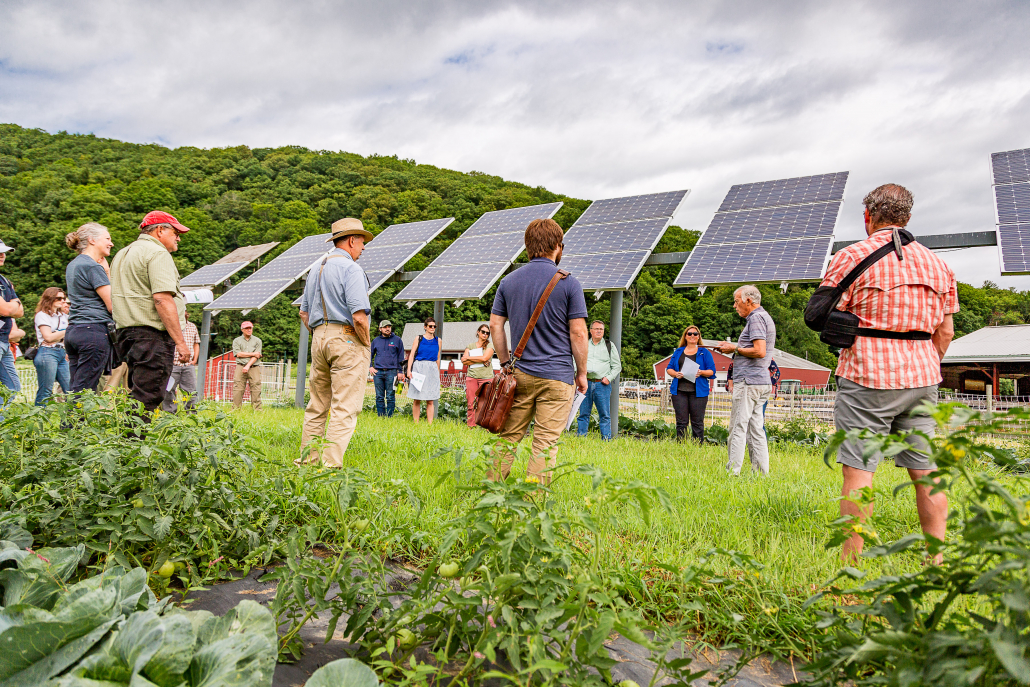
LIHEAP Participants Would Lead to More Energy Savings
Community solar often includes what is known as subscription-based community solar programs (SBCSPs), where a household “rents” solar panels and uses solar energy without the associated conditions and costs of installing solar panels, operating them, or owning them. These conditions of using solar energy typically would not qualify a low-income household to use LIHEAP funds for solar fuel. However, SBCSPs could provide a way for low-income households to be able to use LIHEAP benefit payments for solar fuel through subscription-based community solar programs because the household would not ultimately own the equipment or have to pay for its installation or maintenance costs.
If LIHEAP participants are eligible for SBCSPs, then more people can participate in saving energy by using community agrisolar, which ultimately assists in the identified goal of the Department of Energy (DOE) in reaching $1 billion in energy savings through community solar by 2025.
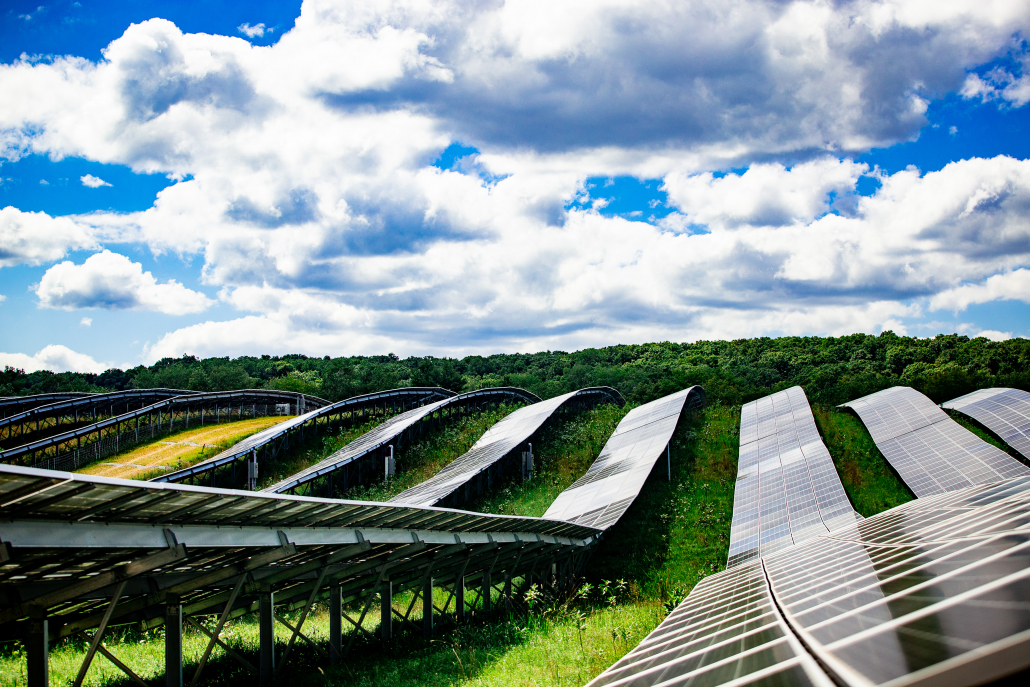
Why merge agrisolar with community solar?
Community solar has been identified by DOE as a method of reaching energy savings goals by 2025, which includes saving $1 billion in energy costs. Merging agrisolar with community solar developments would not only aid in significant energy savings but would also make future solar developments more likely to be approved—expanding energy savings even further.
Agrisolar operations like the Cabriejo Ranch in Missouri has shown that agrisolar provides a variety of energy saving methods as well as regenerating the land used by solar farms. The ranch uses Dorper sheep to manage the vegetation on solar operations, which drastically reduces the use of fuel-operated maintenance equipment typically used to manage vegetation. The sheep not only reduce these energy costs, but dramatically increase the health of the soil .
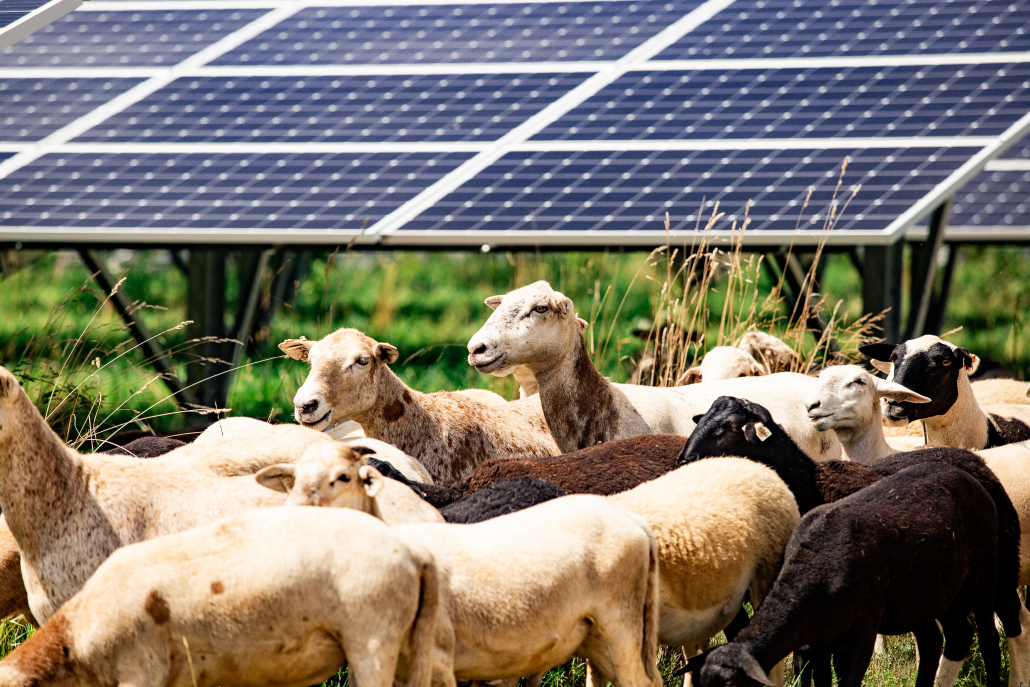
The likelihood of a solar farm being approved for development is higher when Agrisolar is incorporated into the operations. This was seen in the Garnet Mesa project that was denied due to concerns about losing valuable farmland to the solar-farm development. The project was approved after changes were made to include 1,000 grazing sheep on the solar farm.
The Possibilities of Merging Agrisolar and Community Solar
More participants saving more energy would be a win-win for reaching energy-and-cost savings goals.
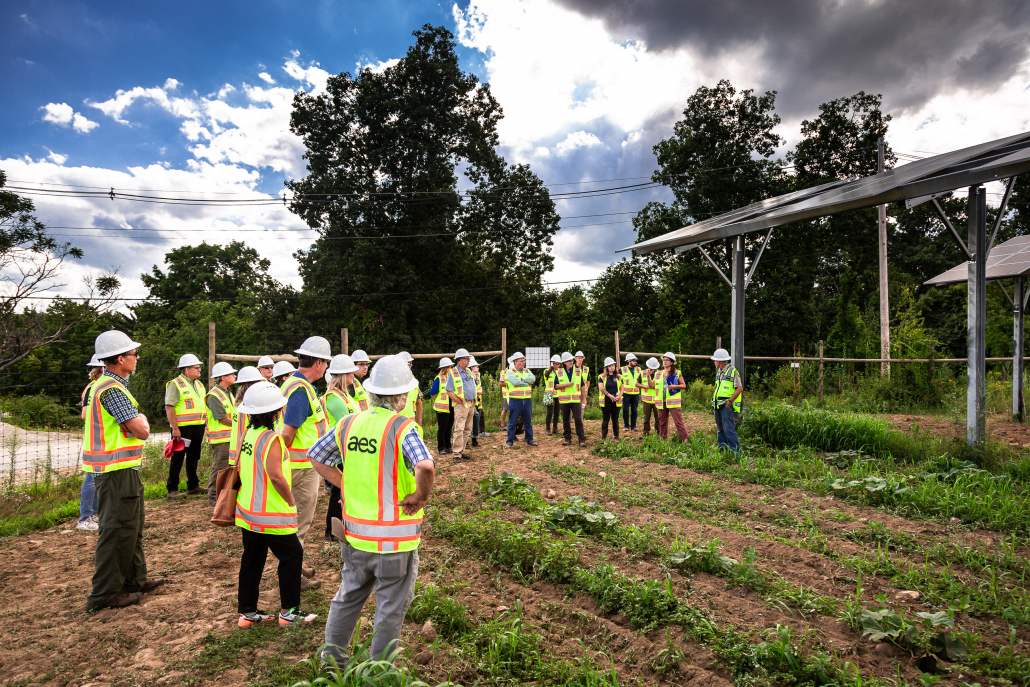
Not only do energy savings goals have a higher likelihood of being achieved through merging community solar and agrisolar, but other benefits of using agrisolar would also be made possible, such as regenerating soil health through grazing practices and supporting job creations in local communities such as grazing management and farm operations jobs created in Missouri. These benefits of using agrisolar in solar development increases the likelihood of future solar developments by proving the land can be effectively utilized while occupied by solar equipment and operations.
By Stacie Peterson, PhD
See more photos from the tour in the AgriSolar Flickr album here: Follow the Sun Tour: Massachusetts | Flickr
The farmlands of Massachusetts are cherished landscapes, steeped in cultural significance and family connections. Coming from the drought-ridden western United States, I was struck first by the lack of irrigation pivots and the lushness of the landscape, even after a heatwave uncommon to the area. I then scanned the rolling hills for solar, excited to see the Massachusetts SMART program in action. I wasn’t disappointed. The solar array at the University of Massachusetts South Deerfield Research Farm presented a picture-perfect site to start our tour.
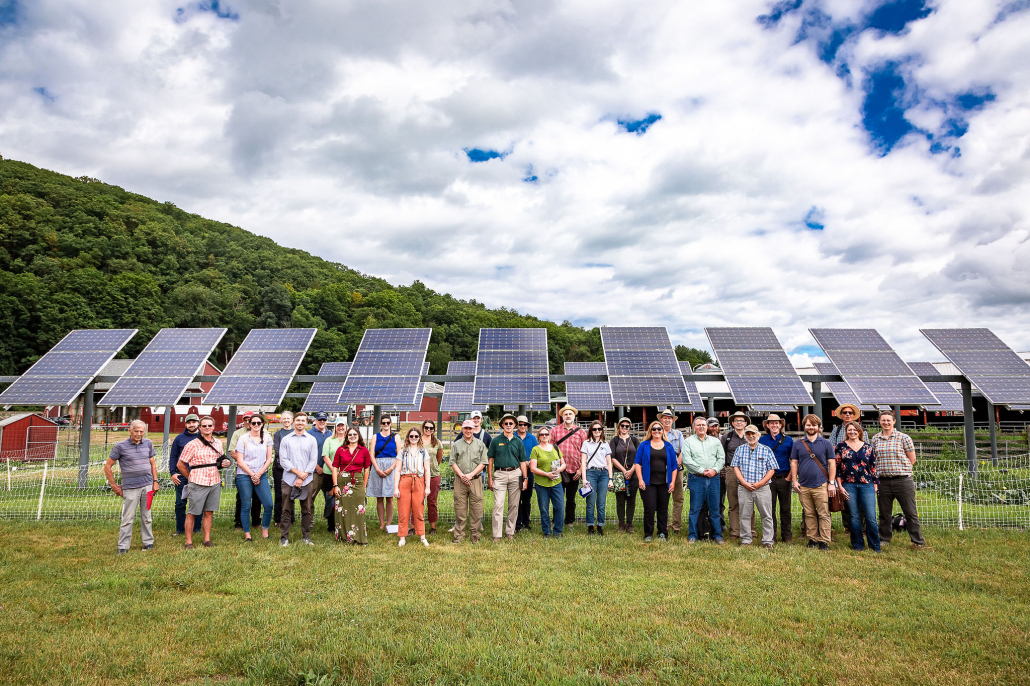
The tour attendees matched my enthusiasm by showing up early and leaning over the fence to better view the solar farm. We were welcomed by Dr. Dwayne Berger from University of Massachusetts, who gave a presentation on the DOE SETO-funded research at the farm. This project involves the study of crop productivity on crops planted under a solar array installed by Hyperion Solar.
Next, Gerry Palano gave a presentation on Massachusetts Agricultural Solar Tariff Generation Units and their relation to agrivoltaics in the Massachusetts Solar Massachusetts Renewable Target (SMART) Program, which provides financial incentives for solar projects. From there, we went out to the farm, where Jake Marley from Hyperion Systems described the solar array design, and Dr. Stephen Herbert discussed the current crops and research at the array.After a quick lunch, we boarded the bus and started our mobile conference of speakers. Dr. Zach Goff-Eldredge kicked off the bus tour with a discussion of DOE SETO’s programs and their support of agrivoltaics.
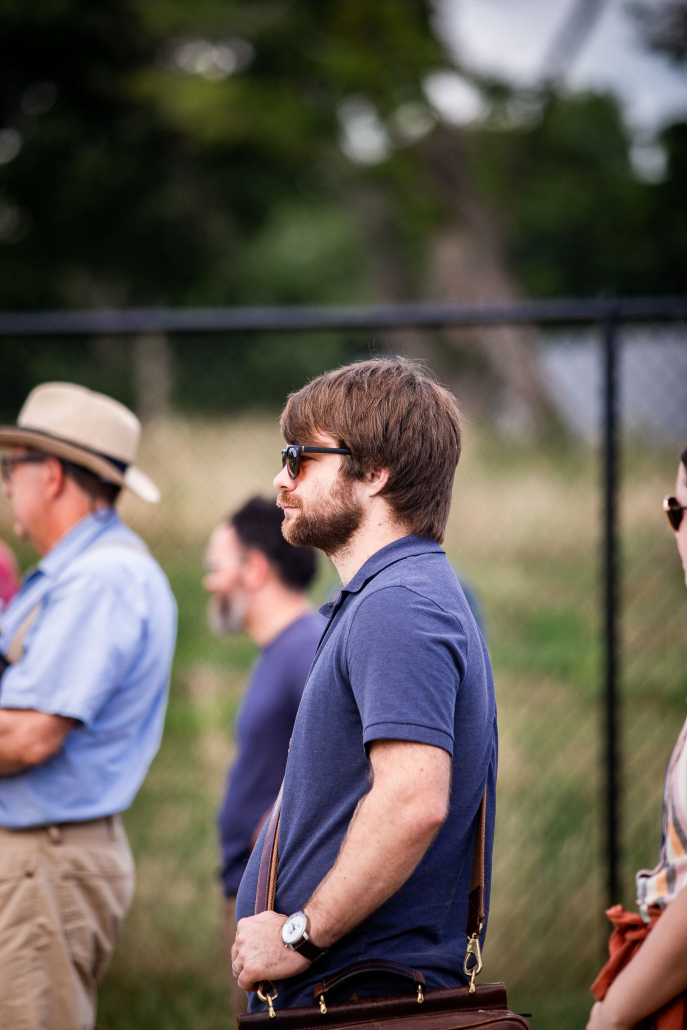
AgriSolar Clearinghouse consultant Alexis Pascaris of AgriSolar Consulting then gave an inspiring talk, envisioning the future of agrisolar from the perspective of farmers, landowners, solar developers, and community members.
Candace Rossi from the New York State Energy Research and Development Authority (NYSERDA) then spoke to the group about the impactful programs in New York State and their relevance to AgriSolar around the country. We arrived at Nate Tassinari’s family farm in Monson with the sun high overhead. Nate welcomed the group to his home and talked about the Million Little Sunbeams project he developed to preserve his family’s farmlands. The farm includes co-located solar and hay, an apiary, and an orchard. As shown in the photo, the 250-kW solar array, installed by Sunbug Solar, has an elevated racking system that accommodates haying equipment. The panels are bifacial, and Nate described the increased solar energy production from the bifacial panels as a result of both hay and snow reflections.
The Million Little Sunbeams project created a financial pathway for Nate and his family to own the land and the solar system; this project does not involve a lease to a solar developer. Nate graciously fielded questions about his process and Gerry Palano fielded questions about the SMART funding piece of the project. Nick d’Arbeloff from Sunbug Solar fielded technical questions about the solar array and site design.
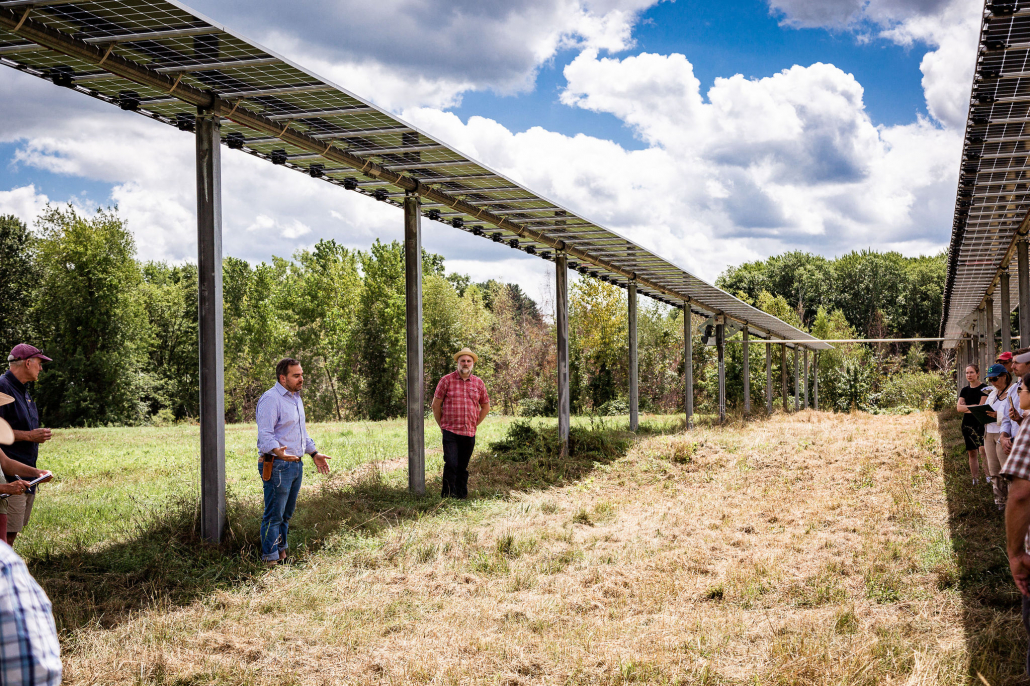
We then travelled to a late-breaking and welcome addition to our tour with Dan Finnegan from Solar Shepherd in Brookfield. On the way, Lexie Hain, former president of the American Solar Grazing Association and current Director of Agrivoltaics and Land Management at Lightsource BP, gave the group a background on solar grazing.When we arrived at Solar Shepherd, Dan’s assistant, Reggie the Wonder Dog, herded the sheep toward the gate to greet us and then herded them to the solar array, so we could witness solar grazing first- hand. Dan described his solar grazing work in Massachusetts and talked with tour members about the practicalities of solar grazing, such as sheep transportation, water needs, leasing, and solar grazing contracts.
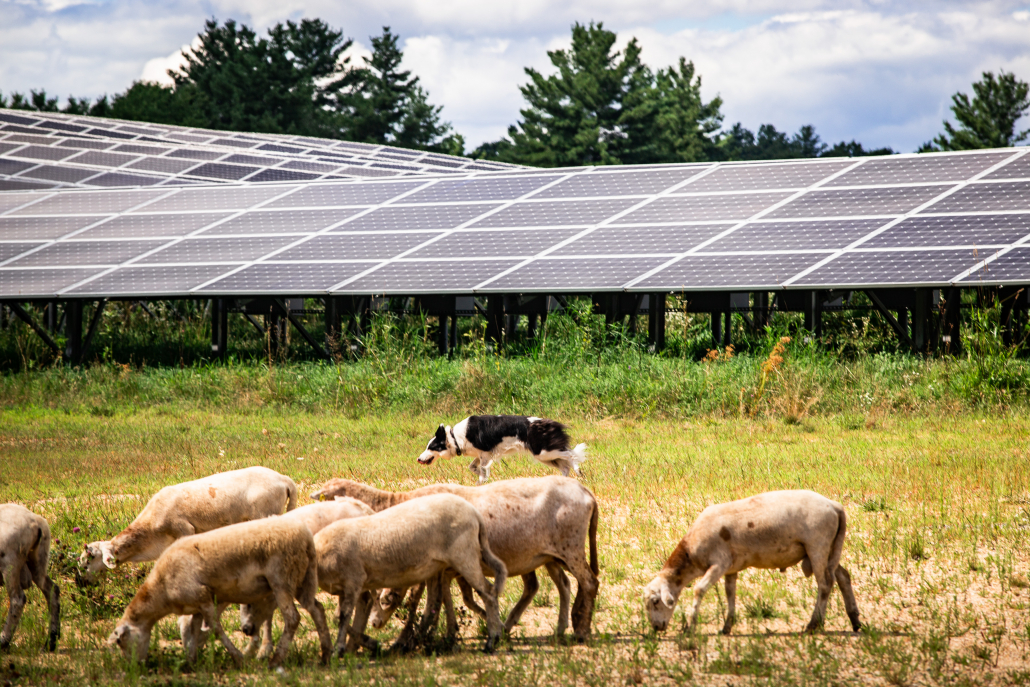
After Solar Shepherd, we boarded the bus to travel to our last agrisolar site: Grafton Solar at Knowlton Farms. On the way, we heard from AgriSolar Clearinghouse stakeholder Ethan Winter from American Farmland Trust (AFT) about AFT work on smart solar siting, agrivoltaics, and at
Grafton Solar at Knowlton Farms provided the tour group with the opportunity to see a large-scale agrisolar site. The 334-acre hay farm includes solar developed in several phases on 75 acres. In addition to Paul Knowlton, fourth-generation family owner of Knowlton Farms, the project includes a slew of agrivoltaic advocates, solar developers, researchers, and the State of Massachusetts.
The agrisolar portion of Knowlton Farms, known as Grafton Solar, is owned and operated by AES Corporation, which pays Knowlton Farms lease payments and a stipend for the cost of farming. The Massachusetts SMART program provided incentives for the project and the University of Massachusetts and American Farmland Trust study the impact of the solar array on crop yields and soil conditions.
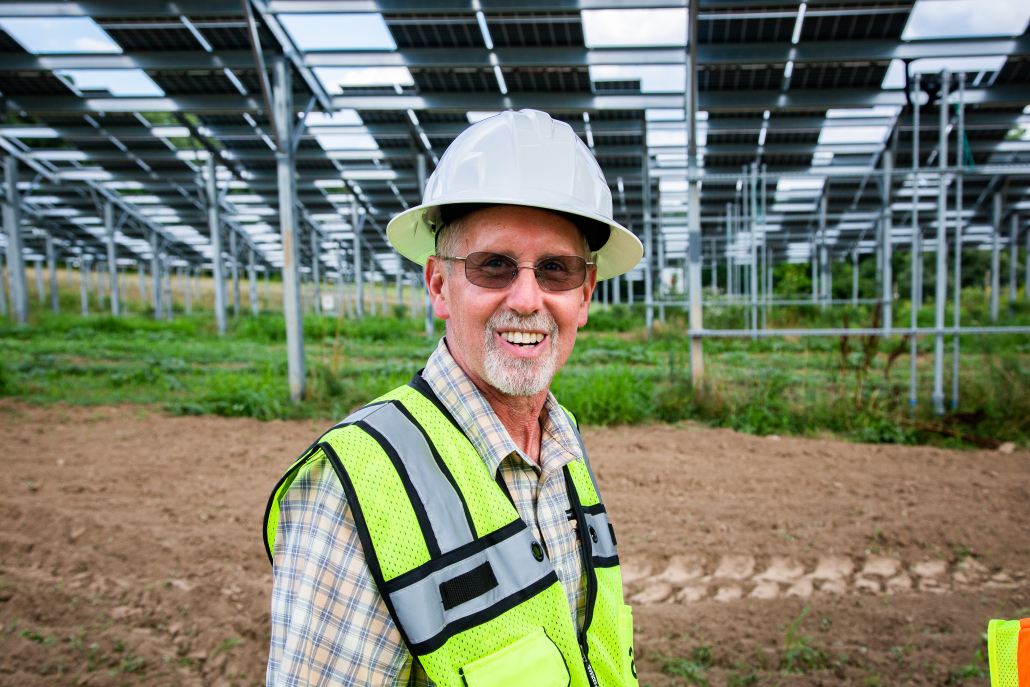
Paul Knowlton talked with the group about his decision to enter into a lease agreement for solar at his farm, its positive financial impact to his family business, and his hopes that the project will help keep the farm in the family well into the future. Dr. Sam Glaze-Corcoran from University of Massachusetts Amherst described soil and crop studies and, along with Gerry Palano and Swayne Berger, fielded questions about how those studies inform University of Massachusetts recommendations to the SMART program. Ian Ward, of Solar Agricultural Services, discussed the site design, plantings, and the potential for this project to serve as an example for other farmers in New England. Ian’s advocacy centers on keeping farmlands in the hands of farmers and in preserving farmlands for the future. Julie Fine, AFT’s Climate and agriculture specialist then led the group crop co-location potion of the site and described her work assessing impacts to crops, soil, and ecosystem services.
The group then boarded the bus for the ride back to Amherst, full of ideas, connections, and energy. Charles Gould, from Michigan State University Extension, talked about his impressions of the day, his work in agrivoltaics, and his thoughts on the future. Judy Anderson, of Community Consultants, led the tour group in a roundtable discussion of the tour, ways to engage policy makers, and how to move forward in a way that supports agrisolar throughout the country.
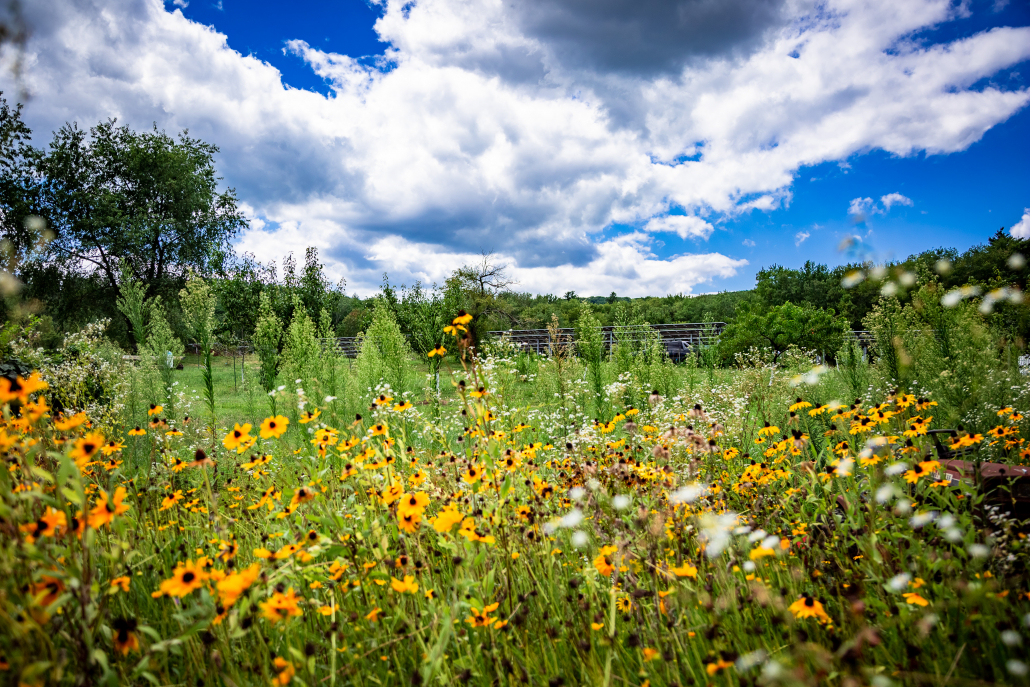
Tours like this are months in the making. From scouting potential sites and tour routes to meetings with farms, solar developers, local governments, and potential speakers. They have the complexity and logistics of a mobile conference. This tour couldn’t have happened without the help of Alexis Pascaris of AgriSolar Consulting and Jake Marley of Hyperion Systems. They were at the heart of this tour and worked with me for months as we planned, connected, and revised. They were flexible with last-minute changes, and I deeply appreciate their contributions to the tour.
I’d like to thank University of Massachusetts for hosting the event at the South Deerfield farm and for allowing us to gather in their meeting space. Thank you, too, to Nate Tassinari for hosting us at his home in Monson; I appreciate his flexibility with last-minute schedule changes and his warm and insightful tour of his farm. Dan Finnegan and Reggie the Wonder Dog deserve a huge round of applause for treating the group to a demonstration of solar grazing in Brookfield. And thank you to Paul Knowlton, The AES Corporation, Ian Ward, Glaze-Corcoran, Julie Fine, Dwayne Berger, and Gerry Palano for the excellent tour of Knowlton Farms. It is a model agrisolar site with impressive research and support.
I’d like to thank the Solar Energy Technology Office of the U.S. Department of Energy for funding this work and Dr. Zach Goff-Eldredge for attending the tour. His support of agrivoltaics is evident around the country and the work the SETO team is doing in this space is creating a pathway for co-located agriculture and solar that works for farmers, community members, and solar developers.
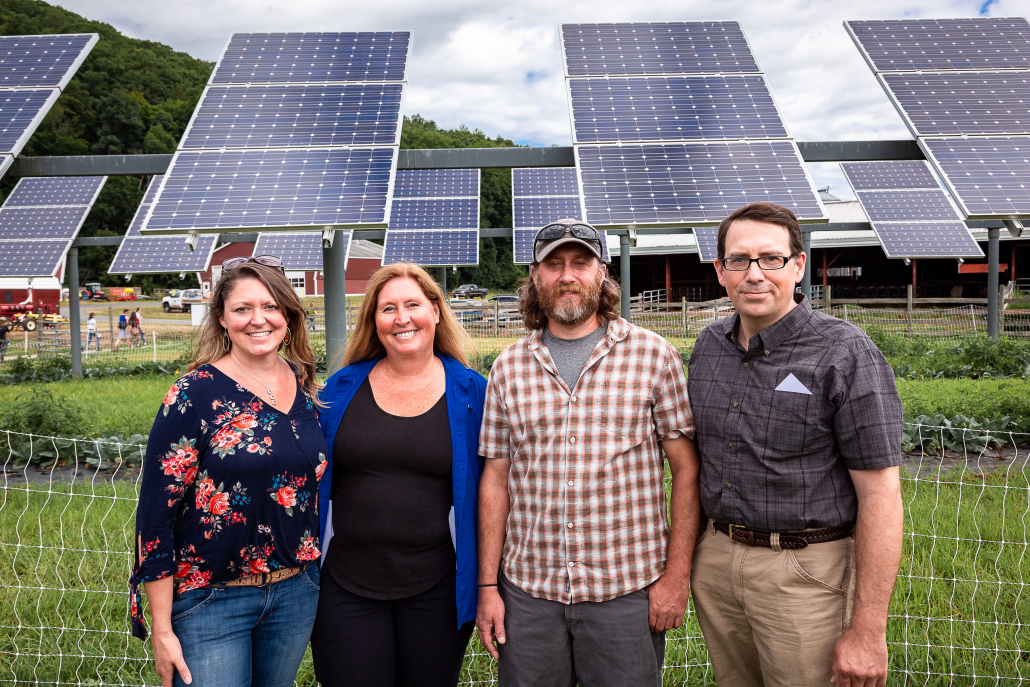
I’d like to thank Danielle Miska, Andy Pressman, and Chris Lent from NCAT for their work on this project and for the AgriSolar Clearinghouse team at NCAT, around the country who cheered us on. I’d also like to thank Nicole Karr, our photographer. It is her beautiful photos throughout this blog. Finally, I’d like to express my gratitude to the tour attendees. The Follow the Sun Tour is one way the AgriSolar Clearinghouse works to build community, relationships, and trusted, practical information and I thank you all for joining us. It was a marathon tour of presentations, site tours, bus speakers, roundtables, networking, honey sticks, and fun. Your energy and enthusiasm are inspiring, and I can’t wait to see you on the road again.
See more photos from the tour in the AgriSolar Flickr album here: Follow the Sun Tour: Massachusetts | Flickr.
Delta County, Colorado, commissioners have given approval to the Garnet Mesa solar farm to proceed with developing a 475-acre, 80-megawatt solar farming facility that was previously rejected due to concerns about losing farmland. After developers modified their plan by added 1,000 sheep to occupy the farm, commissioners voted to grant the land-use permit, satisfied that concerns about losing farmland had been resolved due to the conversion to agrisolar.
“All negative comments were addressed by the applicant except for use of other desert lands for a solar energy facility. Those in favor of bringing a solar energy system to Delta mentioned helping the environment, additional tax revenue for the city, cheaper rates for customers and having a local energy source as reasons to support the proposal,” according to the Delta County Independent.
“Interior fencing will be added to facilitate safe containment for the sheep and to prevent overgrazing. Sheep will also be provided with watering sites and other facilities necessary for safety and well-being, according to project plans presented during an open house,” said the article.
“The two commissioners opposing the plan said they were concerned about the loss of agricultural land in the county. Guzman Energy has revised its Garnet Mesa project to ‘specifically address the agricultural and irrigation concerns raised by the community and commissioners,’ Amy Messenger, a company spokeswoman, said in an email,” according to The Colorado Sun.
Garnet Mesa is expected to produce enough power for 18,000 homes each year and to create an estimated 350 to 400 employment opportunities, including sheep and farm management.
